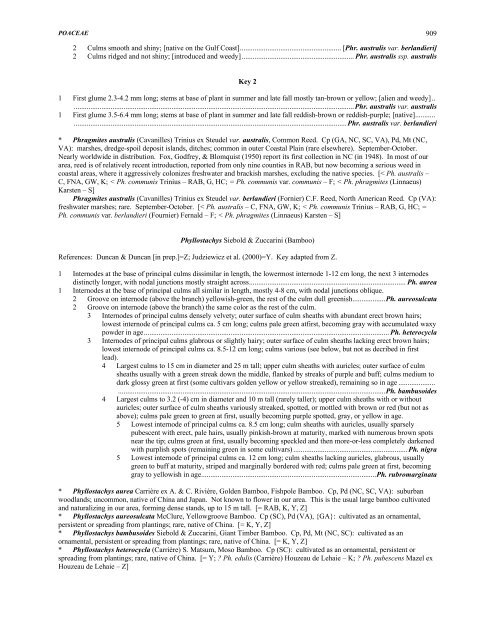Part 7 - UNC Herbarium
Part 7 - UNC Herbarium
Part 7 - UNC Herbarium
You also want an ePaper? Increase the reach of your titles
YUMPU automatically turns print PDFs into web optimized ePapers that Google loves.
POACEAE 909<br />
2 Culms smooth and shiny; [native on the Gulf Coast]....................................................... [Phr. australis var. berlandieri]<br />
2 Culms ridged and not shiny; [introduced and weedy]............................................................. Phr. australis ssp. australis<br />
Key 2<br />
1 First glume 2.3-4.2 mm long; stems at base of plant in summer and late fall mostly tan-brown or yellow; [alien and weedy]..<br />
........................................................................................................................................................Phr. australis var. australis<br />
1 First glume 3.5-6.4 mm long; stems at base of plant in summer and late fall reddish-brown or reddish-purple; [native]...........<br />
....................................................................................................................................................Phr. australis var. berlandieri<br />
* Phragmites australis (Cavanilles) Trinius ex Steudel var. australis, Common Reed. Cp (GA, NC, SC, VA), Pd, Mt (NC,<br />
VA): marshes, dredge-spoil deposit islands, ditches; common in outer Coastal Plain (rare elsewhere). September-October.<br />
Nearly worldwide in distribution. Fox, Godfrey, & Blomquist (1950) report its first collection in NC (in 1948). In most of our<br />
area, reed is of relatively recent introduction, reported from only nine counties in RAB, but now becoming a serious weed in<br />
coastal areas, where it aggressively colonizes freshwater and brackish marshes, excluding the native species. [< Ph. australis –<br />
C, FNA, GW, K; < Ph. communis Trinius – RAB, G, HC; = Ph. communis var. communis – F; < Ph. phragmites (Linnaeus)<br />
Karsten – S]<br />
Phragmites australis (Cavanilles) Trinius ex Steudel var. berlandieri (Fornier) C.F. Reed, North American Reed. Cp (VA):<br />
freshwater marshes; rare. September-October. [< Ph. australis – C, FNA, GW, K; < Ph. communis Trinius – RAB, G, HC; =<br />
Ph. communis var. berlandieri (Fournier) Fernald – F; < Ph. phragmites (Linnaeus) Karsten – S]<br />
Phyllostachys Siebold & Zuccarini (Bamboo)<br />
References: Duncan & Duncan [in prep.]=Z; Judziewicz et al. (2000)=Y. Key adapted from Z.<br />
1 Internodes at the base of principal culms dissimilar in length, the lowermost internode 1-12 cm long, the next 3 internodes<br />
distinctly longer, with nodal junctions mostly straight across..................................................................................... Ph. aurea<br />
1 Internodes at the base of principal culms all similar in length, mostly 4-8 cm, with nodal junctions oblique.<br />
2 Groove on internode (above the branch) yellowish-green, the rest of the culm dull greenish..................Ph. aureosulcata<br />
2 Groove on internode (above the branch) the same color as the rest of the culm.<br />
3 Internodes of principal culms densely velvety; outer surface of culm sheaths with abundant erect brown hairs;<br />
lowest internode of principal culms ca. 5 cm long; culms pale green atfirst, becoming gray with accumulated waxy<br />
powder in age..................................................................................................................................... Ph. heterocycla<br />
3 Internodes of principal culms glabrous or slightly hairy; outer surface of culm sheaths lacking erect brown hairs;<br />
lowest internode of principal culms ca. 8.5-12 cm long; culms various (see below, but not as decribed in first<br />
lead).<br />
4 Largest culms to 15 cm in diameter and 25 m tall; upper culm sheaths with auricles; outer surface of culm<br />
sheaths usually with a green streak down the middle, flanked by streaks of purple and buff; culms medium to<br />
dark glossy green at first (some cultivars golden yellow or yellow streaked), remaining so in age ....................<br />
.................................................................................................................................................Ph. bambusoides<br />
4 Largest culms to 3.2 (-4) cm in diameter and 10 m tall (rarely taller); upper culm sheaths with or without<br />
auricles; outer surface of culm sheaths variously streaked, spotted, or mottled with brown or red (but not as<br />
above); culms pale green to green at first, usually becoming purple spotted, gray, or yellow in age.<br />
5 Lowest internode of principal culms ca. 8.5 cm long; culm sheaths with auricles, usually sparsely<br />
pubescent with erect, pale hairs, usually pinkish-brown at maturity, marked with numerous brown spots<br />
near the tip; culms green at first, usually becoming speckled and then more-or-less completely darkened<br />
with purplish spots (remaining green in some cultivars) ..............................................................Ph. nigra<br />
5 Lowest internode of principal culms ca. 12 cm long; culm sheaths lacking auricles, glabrous, usually<br />
green to buff at maturity, striped and marginally bordered with red; culms pale green at first, becoming<br />
gray to yellowish in age...............................................................................................Ph. rubromarginata<br />
* Phyllostachys aurea Carrière ex A. & C. Rivière, Golden Bamboo, Fishpole Bamboo. Cp, Pd (NC, SC, VA): suburban<br />
woodlands; uncommon, native of China and Japan. Not known to flower in our area. This is the usual large bamboo cultivated<br />
and naturalizing in our area, forming dense stands, up to 15 m tall. [= RAB, K, Y, Z]<br />
* Phyllostachys aureosulcata McClure, Yellowgroove Bamboo. Cp (SC), Pd (VA), {GA}: cultivated as an ornamental,<br />
persistent or spreading from plantings; rare, native of China. [= K, Y, Z]<br />
* Phyllostachys bambusoides Siebold & Zuccarini, Giant Timber Bamboo. Cp, Pd, Mt (NC, SC): cultivated as an<br />
ornamental, persistent or spreading from plantings; rare, native of China. [= K, Y, Z]<br />
* Phyllostachys heterocycla (Carrière) S. Matsum, Moso Bamboo. Cp (SC): cultivated as an ornamental, persistent or<br />
spreading from plantings; rare, native of China. [= Y; ? Ph. edulis (Carrière) Houzeau de Lehaie – K; ? Ph. pubescens Mazel ex<br />
Houzeau de Lehaie – Z]













